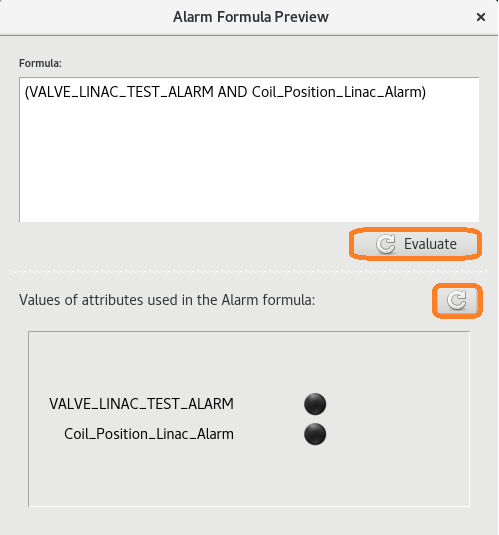Notes on alarms formulas¶
Alarm conditions are provided as python like expressions, which are then calculated by the TangoEval. The TangoEval is an extended python eval.
Detail information and examples of formulas can be found int the PANIC documentation, here:
Tango names resolving¶
The main enhancement to the standard python eval is the direct resolving of tango objects.
If one uses a string like the following (without quotes):
some/device/name{/attribute_name}{.value/all/time/quality/delta/exception}
(items in curly brackets are optional), the TangoEval resolve the string to:
Tango some/device/name State, if the only device name is used,
An attribute value indicated by some/device/name/attribute_name, if the string provides the attribute_name,
An attribute property (value/all/time/quality/delta/exception), if it is provided in the string,
Please refer to this documentation
Special Keys/Macros¶
When providing formulas, the following special kays
DEVICE: Returns PyAlarm device name
DOMAIN, FAMILY, MEMBER: Parts of the device name
ALARMS: Alarms managed by this device
PANIC: API containing all declared alarms
t: time since the device was started
T(…): string to time
str2time(…): string to time
now, NOW(): current timestamp
DEVICES: instantiated devices
DEV(device): DeviceProxy(device)
NAMES(expression): Finds all attributes matching the expression and return its names.
CACHE: Saved values
PREV: Previous values
READ(attr): TangoEval.read_attribute(attr)
FIND(expression): Finds all attributes matching the expression and return its values.
For details, pleas look to the links to Examples provided in the PANIC documentation
Current timestamp - NOW()¶
Time: returns the epoch in seconds of the last value read
epoch is a date and time from which a computer measures system time
sys/tg_test/1/State.time < (now-60)

Fig. 8 NOW()¶
CACHE¶
This will trigger alarm if ALL values in the cache are equal, it is NOT the same as Delta because it checks only the first and last values:
not (lambda l:max(l)-min(l))([v.value for v in CACHE['elin/focus/b1coil/Position']])

Fig. 9 CACHE¶
String to time - T(…)¶
A temporal condition can be achieved using the T() macro in the formula. To re-enable it after a maintenance period:
T() < T('2020-01-09') AND (elin/v-rv/1/State != CLOSE)

Fig. 10 T(…)¶
FIND¶
((elin/focus/b1coil/Position > 55) OR (elin/focus/b2coil/Position > 55) OR elin/focus/b3coil/Position > 55) OR (elin/focus/b4coil/Position > 55))
is equal to:
any([s.value > 55 for s in FIND(elin/focus/b*coil/Position)])

Fig. 11 FIND()¶
Grouping Alarms in Formulas¶
The proper way of grouping the alarms
ALARM_1: just/my/tango/attribute_1
ALARM_1: just/my/tango/attribute_2
then:
ALARM_1_OR_2: ALARM_1 or ALARM_2
Example:
(((elin/v-rv/0/State != CLOSE) OR (elin/v-rv/1/State != CLOSE) OR (elin/v-rv/2/State != CLOSE) OR (elin/v-rv/3/State != CLOSE) OR (elin/v-rv/4/State != CLOSE) ) AND ((elin/focus/b1coil/Position > 55) OR (elin/focus/b2coil/Position > 55) OR (elin/focus/b3coil/Position > 55) OR (elin/focus/b4coil/Position > 55)))
is equal to:
VALVE_LINAC_TEST_ALARM:((elin/v-rv/0/State != CLOSE) OR (elin/v-rv/1/State != CLOSE) OR (elin/v-rv/2/State != CLOSE) OR (elin/v-rv/3/State != CLOSE) OR (elin/v-rv/4/State != CLOSE) )
Coil_Position_Linac_Alarm:((elin/focus/b1coil/Position > 55) OR (elin/focus/b2coil/Position > 55) OR (elin/focus/b3coil/Position > 55) OR (elin/focus/b4coil/Position > 55))
(VALVE_LINAC_TEST_ALARM AND Coil_Position_Linac_Alarm)

Fig. 12 Grouping¶